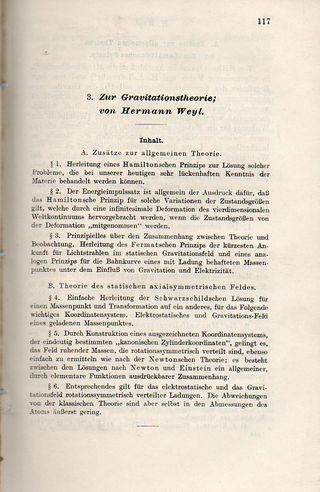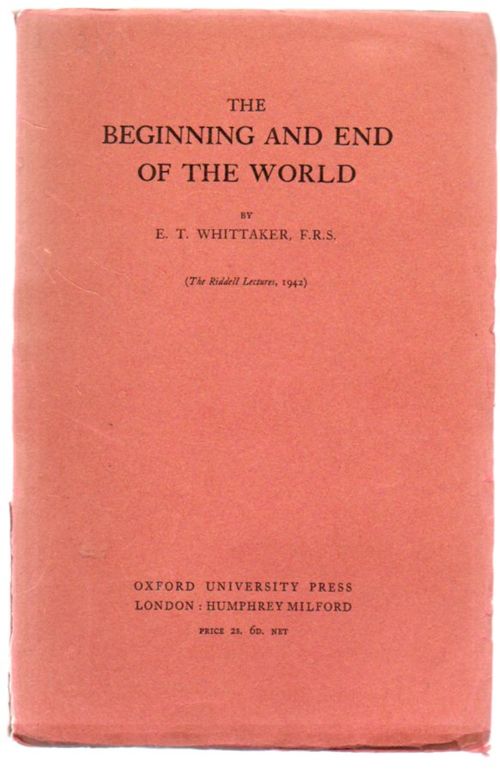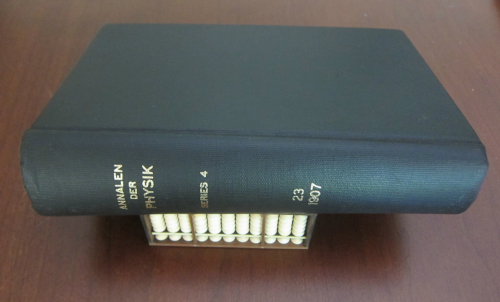 Albert Einstein, three papers in Annalen der Physik, Johannes Barth, 1907, 23(6):
Albert Einstein, three papers in Annalen der Physik, Johannes Barth, 1907, 23(6):
(1) “Ueber die Moeglichkeit einer neuen Pruefung des Relativitatsprinzips” pp 197-198, (Possibility of a new examination of the relativity principle.)
(2) “Bemerkungen zu der Notiz von Hrn. Paul Ehrenfest: "Die translation deformierbarer Elektronen und der Flaechensatz"., pp 206-208, (Comments on the note by Mr Paul Ehrenfest's "Translation of deformed electrons and the surface theorem.)
***(3) “Ueber die vom Relativitsprinzip geforderte Traegheit Energie”, pp 371-384, (On the inertia of energy required by the relativity principle.) This is the first appearance of the full equivalence of mass and energy which would later take the famous form of E=MC2 --in this case it is μ = E0 /V2.
All in Annalen der Physik 23(6) VIII,1000 pp. and 4 plates. Einstein's papers pp. 197-98, 206-209 and 371-384. Weil Nos 17,18, and 19. Recent black cloth, in fine condition. Half-cloth and marbled boards. Provenance: Mathematical Verein Bibliothek, University of Berlin, with their contemporary small rubber stamp on the title page, and another on the text block bottom. $950

Einstein in 1907 is still a year away from his first public lecture, and two years past his miracle year of 1905. He would be appointed to be a professor of physics at the University of Berlin in December 1913.
- [Note: if you go to some of the referenced articles—in particular the one by Hecht—they will refer to this as the “May 1907” paper; Einstein did submit it in May but it is actually published in June.]
“First statement that the total energy of a particle in rest equals E=mc2. Derives the transformation of energy and momentum under the influence of external forces (relativistic dynamics). Notes again the difficulty of applying Lorentz transformations to rigid bodies... Finally, speculates that Maxwell's equations will prove to be the limiting case for large numbers of light-quanta, just as thermodynamics is a limiting case of statistical mechanics.” where E is the total energy, m is the relativistic mass, and c is the vacuum speed of light... --https://en.wikipedia.org/wiki/List_of_scientific_publications_by_Albert_Einstein
Schilpp bibliography 20; Einstein Collected Papers vol 2/4
“In the last section of this May 1907 paper, Einstein, seeking “the simplest expression for E,” the total energy, set E0=mc2 for the very first time. Here, E0 is the energy “for the stationary mass-point;” the term rest-energy was still not part of his lexicon.”--Hecht, Eugene. “How Einstein confirmed E 0 = m c 2” American Journal of Physics, 06/2011, Volume 79, Issue 6
“... many textbooks and articles credit (Einstein) with the relation E=mc2, where E is the total energy, m is the relativistic mass, and c is the vacuum speed of light. Einstein never derived this relation, at least not with that understanding of the meaning of its terms. He consistently related the “rest energy” of a system to its invariant inertial mass.”--Hecht, Eugene. “How Einstein confirmed E 0 = m c"
“The assistant examiner at the Patent Office did not derive the equation E0=mc2, or anything like it, from first principles in 1905. “--Hecht paper
"The treatment outlined here, in which the notation has been simplified, is true to the original derivation. Although it is routinely claimed that this analysis provided the definitive proof of E=mc2, it did not. Moreover, the youthful savant was aware that this inquiry, which he astutely labeled a “special case,” did not provide a complete proof of the mass-energy equivalence. Indeed, he later (1907) spoke of that equivalence as “an assumption of such extraordinary generality, “On the inertia of energy required by the relativity principle” (May 1907) [which is the paper we are discussing] rather than a proven fact.”--Hecht paper
Hecht then begins a long section of the 1907 Annalen paper (followed by the Radioaktivitat paper of December 1907) so: “Two remarkable 1907 papers. //close head// Einstein was not content with his earlier treatments of mass-energy, and returned to the subject in his next paper, “On the inertia of energy required by the relativity principle”.
“In "Does the inertia of a body depend upon its energy content?' (1905), Einstein used V to mean the speed of light in a vacuum and L to mean the energy lost by a body in the form of radiation.Consequently, the equation E = mc2 was not originally written as a formula but as a sentence in German saying that if a body gives off the energy L in the form of radiation, its mass diminishes by LV2”--wiki entry on The equivalency of mass and energy.
“On page 382 [of the Annalen paper] Einstein considers the total energy of a moving mass point as the sum of its kinetic energy and its rest energy. In classical mechanics it is most convenient to set the second term to zero but in relativistic mechanics one obtains the simplest expression by setting the rest energy equal to mc2. Einstein then continues to show that this stipulation cannot lead to a contradiction in any relativistic argument. In a footnote on page 382 Einstein states for the first time the equation E=mc2 and mentions that this equation is the expression of the principle of the equivalence of mass and energy - see Volume 2 of 'The Collected Papers of Albert Einstein' pp. 428.
“The first record of the relationship of mass and energy explicitly in the form E = mc2 was written by Einstein in a review of relativity in 1907.”
“A first milestone of this exploration [“specific heat”] was Einstein's 1907 paper on the specific heat of solid bodies,
which exploited the insight into the non-classical behavior of atomic oscillators for a new understanding of the thermal
properties of solid bodies, in particular at lower temperatures. The experimental confirmation in Nernst's laboratory of
the prediction of the decrease of specific heats with temperature turned out to be crucial for Einstein's career and his
eventual move to Berlin in 1914.”--from Einstein in the Annalen, http://einstein-annalen.mpiwg-berlin.mpg.de/home
Footnote translated: "One should note that the simplifying stipulation uV2=E0 ε is also the expression of the principle of the equivalence of mass and energy, and in the case of the electrified body E0 is noting other than its electrostatic energy.” Where V=speed of light in a vacuum (as also used in the 1905 paper) and E0 being the energy of a system of mass points."
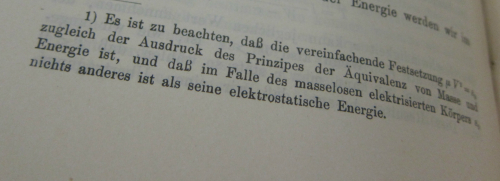
“In May 1907, Einstein explained that the expression for energy ε of a moving mass point assumes the simplest form, when its expression for the state of rest is chosen to be ε0 = μV2 (where μ is the mass), which is in agreement with the "principle of the equivalence of mass and energy. In addition, Einstein used the formula μ = E0 /V2, with E0 being the energy of a system of mass points to describe the energy and mass increase of that system when the velocity of the differently moving mass points is increase.”
See:
Schwartz, H. M. “Einstein’s comprehensive 1907 essay on relativity, part II”, American Journal of Physics, 09/1977, Volume 45, Issue 9/
Mamedov, B.A; Esmer, M.Y. “On the philosophical nature of Einstein's mass-energy equivalence formula E = [mc.sup.2]” Foundations of Science, 11/2014, Volume 19, Issue 4
Hecht, Eugene. “How Einstein confirmed E 0 = m c 2” American Journal of Physics, 06/2011, Volume 79, Issue 6
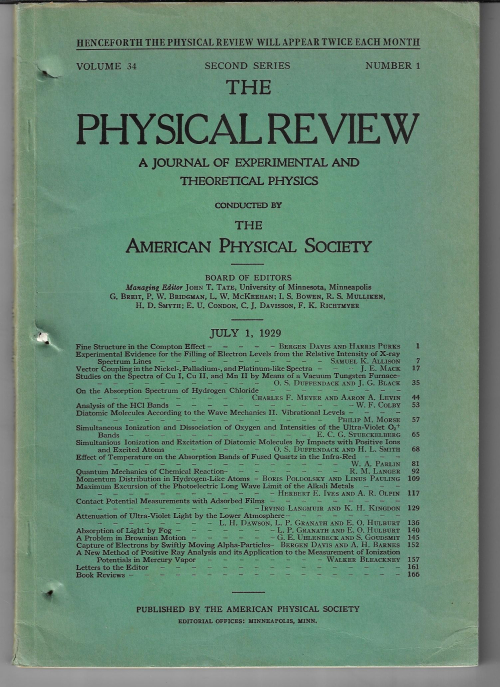 H.P. Robertson, "The Uncertainty Principle", in Physical Review, July 1, 1929, Volume 34 number 1, pp 163-4 in the issue of pp 1-166 (plus ads). Original wrappers. Three-ring-punch holes in the left side of the publication from where the issues for the half-year were gathered up and bound. Other than this (big) thing, a nice copy., and reflected in the much-reduced price. $150
H.P. Robertson, "The Uncertainty Principle", in Physical Review, July 1, 1929, Volume 34 number 1, pp 163-4 in the issue of pp 1-166 (plus ads). Original wrappers. Three-ring-punch holes in the left side of the publication from where the issues for the half-year were gathered up and bound. Other than this (big) thing, a nice copy., and reflected in the much-reduced price. $150




